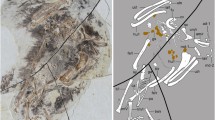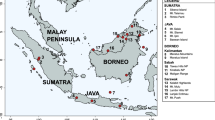Abstract
A robust phylogeny estimate for the family Furnariidae (sensu lato) was obtained using sequences of two nuclear introns and one mitochondrial gene (cyt b). Contrary to the widely accepted sister-group relationship of ovenbirds (Furnariinae) and woodcreepers (Dendrocolaptinae), a basal clade is suggested for Sclerurus and Geositta, while Xenops, hitherto considered an aberrant ovenbird, was found to occupy a basal position on the woodcreeper lineage. The morphological variation is re-interpreted in view of this revised phylogenetic hypothesis. Presumably, the remarkable adaptive radiation in this family started as primitive, Sclerurus-likes forms, which used the tail as a prop during terrestrial feeding, lured up to seek food on tree-trunks. The two basal woodcreeper genera, Xenops and then Glyphorynchus, show strong cranial specializations for hammering in wood, thus presenting a remarkable parallelism with the family Picidae, Xenops resembling a piculet, Glyphorynchus, a diminutive woodpecker. However, this specialization was lost in other woodcreepers, which show a more normal passerine skull, adapted for probing and prying in tree-trunk crevices and sallying for escaping insects. The ovenbirds developed a more flexible (rhynchokinetic) bill, well suited for probing and retrieving hidden prey in dead-leaf clusters and debris suspended in the vegetation, and in epiphyte masses. Adaptations to live in open terrain are secondary.





Similar content being viewed by others
References
Akaike H (1973) Information theory as an extension of the maximum likelihood principle. In: Petrov BN, Csaki F (eds) Second international symposium on information theory. Akademini Kiado, Budapest, pp 267–281
Alexio A (2002) Molecular systematics and the role of the “Várzea”-”Terra-Firme” ecotone in the diversification of Xiphorhynchus woodcreepers (Aves: Dendrocolaptidae). Auk 119:621–640
Alström P, Ödeen A (2002) Incongruence between mitochondrial DNA, nuclear DNA and non-molecular data in the avian genus Motacilla: implications for estimates of species phylogenies. In: Alström P Species limits and systematics in some passerine birds. PhD Thesis, Uppsala University, Sweden
Ames PL (1971) The morphology of the syrinx in passerine birds. Bull Peabody Mus Nat Hist 37:1–194
Bock WJ (1964) Kinetics of the avian skull. J Morph 114:1–42
Bock WJ (1999) Functional and evolutionary morphology of woodpeckers. Ostrich 70:23–31
Chesser RT (2004) Molecular systematics of New World Suboscine birds. Mol Phyl Evol (in press)
Cibois A, Kalyakin MV, Lian-Xian H, Pasquet E (2002) Molecular phylogenetics of babblers (Timaliidae): revaluation of the genera Yuhina and Stachyris. J Avian Biol 33:380–390
Clench MH (1995) Body pterylosis of woodcreepers and ovenbirds (Dendrocolaptidae and Furnariidae). Auk 112:800–804
Degnan S (1993) The perils of single gene trees mitochondrial versus single-copy nuclear DNA variation in white-eyes (Aves: Zosteropidae). Mol Ecol 2:219–225
Desjardins P, Morais R (1990) Sequence and gene organization of the chicken mitochondrial genome: a novel gene order in higher vertebrates. J Mol Biol 212:599–634
Edwards SV, Wilson AC (1990) Phylogenetically Informative length polymorphism and sequence variability in mitochondrial DNA of Australian songbirds (Pomatostomus) Genetics 126:695-711
Ericson PGP, Christidis L, Irestedt M, Norman JA (2002) Systematic affinities of the lyrebirds (Passeriformes: Menura), with a novel classification of the major groups of passerine birds. Mol Phyl Evol 25:53–62
Ericson PGP, Christidis L, Cooper A, Irestedt M, Jackson J, Johansson US, Norman JA (2002) A Gondwanan origin of passerine birds supported by DNA sequences of the endemic New Sealand wrens. Proc R Soc Lond B 269:235–241
Feduccia A (1973) Evolutionary trends in the Neotropical ovenbirds and woodhewers. Ornithol Monogr 13:1–69
Fjeldså J, Zuccon D, Irestedt M, Johansson US, Ericson PG (2003) Sapayoa aenigma: a New World representative of ‘Old World suboscines’. Proc R Soc Lond B. [Suppl] 270:238–241
Fürbringer M (1888) Untersuchungen zur Morphologie und Systematik der Vögel, vols 1, 2. Holkema, Amsterdam
Heimerdinger MA, Ames PL (1967) Variation in the sternal norches of suboscine passeriform birds. Postilla Peabody Mus 105:1–44
Hellmayr CE (1925) Catalogue of birds of the Americas, pt 4.Field Mus Nat Hist Zool Ser 13
Heslewood MM, Elphinstone MS, Tidemann SC, Baverstock PR (1998) Myoglobin intron variation in the Gouldian Finch Erythrura gouldiae assessed by temperature gradient gel electrophoresis. Electrophoresis 19:142 –151
Holder M., Lewis PO (2003) Phylogeny estimation: Traditional and Bayesian approaches. Nat Gen 4:275–284
Huelsenbeck JP, Ronquist F (2001) MrBAYES: Bayesian inference of phylogenetic trees. Bioinformatics 17:754–755
Huelsenbeck JP, Larget B, Miller RE, Ronquist F (2002) Potential applications and pitfalls of Bayesian inference of phylogeny. Syst Biol 51:673–688
Irestedt M, Fjeldså J, Johansson US, Ericson PGP (2002) Systematic relationships and biogeography of the tracheophone suboscines (Aves: Passeriformes). Mol Phyl Evol 23:499–512
Irestedt M, Fjeldså J, Ericson PGP (2004a) Phylogeny and morphological plasticity in woodcreepers (Dendrocolaptinae). J Avian Biol 35:280–288
Irestedt M, Fjeldså J, Nylander JAA, Ericson PGP (2004b) Phylogenetic relationships of typical antbirds (Thamnophilidae) and test of incongruence based on Bayes factors. BMC Evol Biol 4:23
James HF, Ericson PGP, Slikas B, Lei F-M, Gill FB, Olson SL (2003) Pseudopodoces humilis, a misclassified terrestrial tit (Aves: Paridae) of the Tibetan Plateau: evolutionary consequences of shifting adaptive zones. Ibis 145:185–202
Johansson US, Irestedt M, Parsons TJ, Ericson PGP (2002) Basal phylogeny of the Tyrannoidea based on comparisons of cytochrome b and exons of nuclear c-myc and RAG-1 genes. Auk 199:984–995
Kocher TD, Thomas WK, Meyer A, Edwards SV, Pääbo S, Villablanca FX, Wilson AC (1989) Dynamics of mitochondrial DNA evolution in animals: Amplification and se-quencing with conserved primers. Proc Nat Acad Sci USA 86:6196–6200
Kratter AW, Parker TA III (1997) Relationship of two bamboo-specialized foliage-gleaners: Automolus dorsalis and Anabazenops fuscus (Furnariidae). Ornithol Monogr 48:383–397
Leisler B (1977) Ökomorphologische Aspekte von Speziation und adaptiver Radiation bei Vögeln. Vogelwarte 29:136–153
Lipscomb D, Platnick N, Wheeler Q (2003) The intellectual content of taxonomy: a comment on DNA taxonomy. Trends Ecol Evol 18:65–66
Maddison WP, Donoghue MJ, Maddison DR (1984) Outgroup analysis and parsimony. Syst Zool 33:83–103
Marantz CA, Aleixo A, Bevier LR, Patten MA (2003) Family Dendrocolaptidae (Woodcreepers). In: del Hoyo J, Elliot A, Christie D (eds) Handbook of the birds of the world, vol 8. Lynx, Barcelona, pp 358–447
Moore WS (1995) Inferring phylogenies from mtDNA variation: mitochondrial-gene trees versus nuclear-gene trees. Evolution 49:718–726
Moore WS, DeFillipis VR (1997) The window of taxonomic resolution for phylogenies based on mitochondrial cytochrome b. In: Mindell DP (ed) Avian molecular evolution and systematics. Academic Press, London, pp 83–119
Müller JP (1878) On certain variation in the vocal organs of the Passeres that have hitherto escaped notice. Macmillan, London
Nylander JAA (2002) MrModeltest v.1.0. Program distributed by the author. Department of Systematic Zoology, Uppsala University, Uppsala
Raikow RJ (1994) A phylogeny of the woodcreepers (Dendrocolaptinae). Auk 111:104–114
Raven PH, Axelrod D (1975) History of the flora and fauna of Latin America. Am Sci 63:420–429
Remsen JV Jr (2003) Family Furnariidae (Ovenbirds). In: del Hoyo J, Elliot A, Christie D (eds) Handbook of the birds of the world, vol 8. Lynx, Barcelona, pp 162–357
Ridgely RS, Tudor G (1994) The birds of South America, vol II. Oxford University Press, Oxford
Ronquist F, Huelsenbeck JP (2003) MrBAYES 3: Bayesian phylogenetic inference under mixed models. Bioinformatics 19:1572–1574
Rosenberg KV (1997) Ecology of dead-leaf foraging specialists and their contribution to Amazonian bird diversity. Ornithol Monogr 48:673–700
Sclater PL (1890) Catalogue of the birds in the British Museum, vol 15. British Museum, London
Sibley CG, Ahlquist JE (1990) Phylogeny and classification of birds. Yale University Press, New Haven, Conn.
Slade RW, Moritz C, Heideman A, Hale PT (1993) Rapid assessment of single-copy nuclear DNA variation in diverse species. Mol Ecol 2:359 –373
Swofford DL (1998) Paup*. Phylogenetic analysis using parsimony (* and other methods), v.4. Sinauer, Sunderland, Mass.
Vaurie C (1971) Classification of the ovenbirds (Furnariidae). Witherby, London
Vaurie C (1980) Taxonomy and geographical distribution of the Furnariidae (Aves, Passeriformes). Bull Am Mus Nat Hist 166:1–357
Willis EO (1994) Review of: evolutionary trends in the Neotropical ovenbirds and woodhewers. Wilson Bull 86:487–489
Zusi RL (1967) The role of the depressor mandibulae muscle in kinesis of the avian skull. Proc US Natl Mus 123:1–28
Zyskowski K, Prum RO (1999) Phylogenetic analysis of the nest architecture of neotropical ovenbirds (Furnariidae). Auk 116:891–911
Acknowledgements
Tissue samples were collected over many years by the Swedish Museum of Natural History in collaboration with the Museo Nacional de Historia Natural del Paraguay, San Lorenzo, and by the Zoological Museum, University of Copenhagen supported by the Danish Research Council (mainly grants 11–0380 and 9502155). Important samples were also obtained from the American Museum of Natural History, New York (Paul Sweet). Mari Källersjö and Pia Eldenäs provided logistic support and advice for the work at the Molecular Systematics Laboratory at the Swedish Museum of Natural History. We are also grateful to Jan Ohlson and Dario Zuccon for assistance with sequence procedures. Funding for the laboratory work was provided by the Swedish Research Council (grant no. 621–2001–2773). Jan Bolding Kristensen is thanked for careful preparation of skeletons, and Gary Graves and Storrs Olson for providing a Xenops skeleton. Also thanks to Per Christiansen for comments on the morphological observations and for agreeing to follow up with a more thorough ecomorphological analysis of the cranial morphology of Xenops and Glyphorynchus skulls. Bruno Walther is thanked for translations to German.
Author information
Authors and Affiliations
Corresponding author
Additional information
Communicated by A.J. Helbig
Electronic Supplementary Material
Rights and permissions
About this article
Cite this article
Fjeldså, J., Irestedt, M. & Ericson, P.G.P. Molecular data reveal some major adaptational shifts in the early evolution of the most diverse avian family, the Furnariidae. J Ornithol 146, 1–13 (2005). https://doi.org/10.1007/s10336-004-0054-5
Received:
Revised:
Accepted:
Published:
Issue Date:
DOI: https://doi.org/10.1007/s10336-004-0054-5




